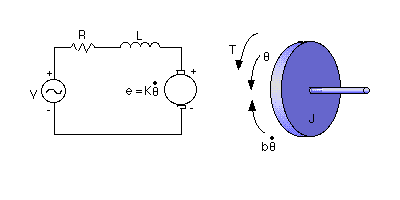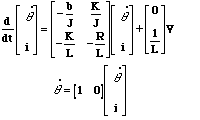Physical
setup and system equations
Design
requirements
Matlab
representation and open-loop response
Physical setup and system equations
A common actuator in control systems is the DC motor. It directly provides rotary motion and, coupled with wheels or drums and cables, can provide transitional motion. The electric circuit of the armature and the free body diagram of the rotor are shown in the following figure:

For this example, we will assume the following values for the physical parameters. These values were derived by experiment from an actual motor in Carnegie Mellon's undergraduate controls lab.
* damping ratio of the mechanical system (b) = 0.1 Nms
* electromotive force constant (K=Ke=Kt) = 0.01 Nm/Amp
* electric resistance (R) = 1 ohm
* electric inductance (L) = 0.5 H
* input (V): Source Voltage
* output (theta): position of shaft
* The rotor and shaft are assumed to be rigid
The motor torque, T, is related to the armature current, i, by a constant factor Kt. The back emf, e, is related to the rotational velocity by the following equations:

In SI units (which we will use), Kt (armature constant) is equal to Ke (motor constant).
From the figure above we can write the following equations based on Newton's law combined with Kirchhoff's law:

1. Transfer Function
Using Laplace Transforms, the above modeling equations can be expressed in terms of s.


By eliminating I(s) we can get the following open-loop transfer function, where the rotational speed is the output and the voltage is the input.

2. State-Space
In the state-space form, the equations above can be expressed by choosing the rotational speed and electric current as the state variables and the voltage as an input. The output is chosen to be the rotational speed.

Design requirements
First, our uncompensated motor can only rotate at 0.1 rad/sec with an input voltage of 1 Volt (this will be demonstrated later when the open-loop response is simulated). Since the most basic requirement of a motor is that it should rotate at the desired speed, the steady-state error of the motor speed should be less than 1%. The other performance requirement is that the motor must accelerate to its steady-state speed as soon as it turns on. In this case, we want it to have a settling time of 2 seconds. Since a speed faster than the reference may damage the equipment, we want to have an overshoot of less than 5%.If we simulate the reference input (r) by an unit step input, then the motor speed output should have:


